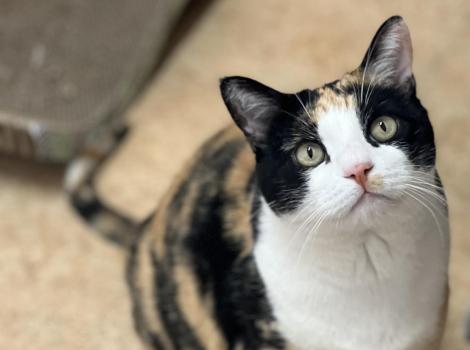Faces of No-Kill: Kittens heal from contagious condition

The Faces of No-Kill series highlights stories about pets who have become a statistic in the best way. These are just a few of the many pets who once slipped into danger; they lost their homes, they had health or behavioral challenges, their families couldn’t care for them, or all the above. But each one of them got assistance, and today they are thriving thanks to an animal shelter program that helped them rather than killed them. Best Friends’ goal is for every animal shelter and every community to reach no-kill by 2025. The story below is just one example of why it’s so important.
Cats with contagious diseases often find themselves in a tough spot in a shelter. It can take several weeks for them to clear their medical issues before they can be adopted, and the added stress of a shelter environment often prolongs their recovery. Because they take up cage space for much longer than healthy cats, many cats who have contagious, but treatable, illnesses don't make it out of shelters. Foster homes can literally save their lives.
These cats recover from illness so much faster when they're in a foster home thanks to the reduction in stress. However, most foster families have their own pets to care for, and understandably they're hesitant to bring potential health challenges into the mix.
I was one of the hesitant ones. With a one-bedroom apartment and three curious cats of my own, I’d never considered fostering kittens who had something that could spread to my own cats. But then, earlier this year two special kittens came into my life, and everything changed.
[Swift action saves young kitten’s life]
I rarely foster "easy" kittens. With over a decade of fostering under my belt, I'm all in for kittens who need extra care. When I'm ready for a new litter of foster kittens, I reach out to my Best Friends colleagues on the Los Angeles foster team and ask them which babies need me most. This time I was sent photos of an adorable pair of kittens.
There had been a third kitten in the litter who had just passed away unexpectedly, and one of the surviving kittens was about half the size she should have been at 5 weeks old. They were both what we call "unthrifty." Unthrifty cats and kittens are smaller and thinner than they should be and have very poor coats.
Both kittens were dehydrated and had diarrhea, nausea, and vomiting. But that wasn’t all. Their fur was thin, greasy, and covered in flakes, and the tops of their little heads were covered in tiny bumps. It turned out that both kittens had sarcoptic mange, also known as scabies.

Crash course in caring for kittens with scabies
Feline scabies, also known as sarcoptic mange, is a skin disease caused by tiny mites known as Notoedres cati. Mange causes extreme itching and scratching, discomfort, hair loss, sores, and general misery. I knew all this already, but I didn't know how the mites spread.
I wasn't sure just how much I’d need to alter my everyday life to take care of these kittens. I would need to keep them in a separate room so that my cats wouldn't catch it. But could the mites jump off the kittens and fly under the door? Should I even do this? Leaving them at the center wasn’t a good option because every space was filled with other cats and kittens from shelters, and these kittens would take up a cage in the medical area for at least four weeks until they cleared scabies. Fostering these kittens meant I would directly impact lifesaving efforts. I had to figure this out.
[There’s a fungus among us and it’s OK]
So I hit the books. I read a bunch of articles and medical papers and learned that scabies mites can't fly or jump. They can only move from one body to another if there is direct and prolonged physical contact. What a relief!
Armed with this knowledge and feeling much less stressed about the situation, I transformed my bathtub into a kitten paradise.
The medical team gave them each a dose of selamectin, a topical medication used to treat parasites in cats and dogs. They also received anti-nausea injections and appetite stimulants. And I went home with probiotics, subcutaneous fluids, vitamin B12 shots, antibiotics, and future doses of selamectin to help these two on their road to recovery. They also got new names: The larger boy was Pickle and the tiny girl Chip.
I was eager to work my magic with these babies and help them become the healthy, gorgeous kittens they were meant to be.

Setting up kittens in a bathtub
I've heard people say "you can foster kittens in your bathtub" countless times, but it was not something I'd ever planned on doing. It seemed cold and a little sad to me. But now that I had to do this, I was determined to make Pickle and Chip’s tub home as warm and cozy as possible. I put down blankets and a heating pad, along with toys, stuffed animals, and their food and litter. It actually looked quite cozy, and the kittens seemed to love their new space.
Over the next four weeks, those two sweet kittens recovered beautifully in the tub. I kept the bathroom door closed overnight and when I wasn't home, but the rest of the time the door stayed open so the kittens could see and hear life going on outside the bathroom.
They got lots of love from me throughout the day and were able to run around the bathroom each time I'd shower. They thrived in this setup, and honestly it wasn't that difficult. I applied a squirt of topical medication every other week and changed their bedding every day; that was it. I can't believe I avoided such a lifesaving opportunity for 10 years, thinking it was impossible.

A case for fostering contagious kittens
Once they healed, Pickle and Chip could safely explore the rest of the apartment and meet my cats. Then they quickly got adopted into wonderful homes. They are happy, healthy, well-adjusted cats, and they are so loved. And their fur is gorgeous.
Once I fully understood scabies, my world changed, and I realized how doable this was. You can foster cats who have a contagious illness, even in a one-bedroom apartment with your own pets.
The most vulnerable cats in shelters need us to step up and give them a chance and the care they deserve. Trust me, opening your home to a cat who needs more care is not as challenging as it may seem, and the rewards are simply immeasurable.

Let's make every shelter and every community no-kill by 2025
Our goal at Best Friends is to support all animal shelters in the U.S. in reaching no-kill by 2025. No-kill means saving every dog and cat in a shelter who can be saved, accounting for community safety and good quality of life for pets.
Shelter staff can’t do it alone. Saving animals in shelters is everyone’s responsibility, and it takes support and participation from the community. No-kill is possible when we work together thoughtfully, honestly, and collaboratively.






